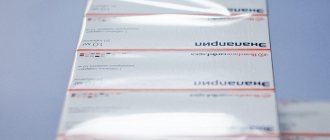Description of the drug
The Infanrix vaccine is the latest combined vaccine based on safe pertussis antigens, the first vaccine in Russia for the prevention of whooping cough, diphtheria and tetanus with an acellular pertussis component.
Infanrix is used to prevent diseases characterized by severe course and possible death. The relevance and prevalence of these infections continues to this day, and the low incidence rate is ensured solely by creating an “immune layer” through vaccination from an early age.
Why vaccinate your child against tetanus?
Tetanus is extremely dangerous: the mortality rate from this disease reaches 80% of the number of cases, among newborns - 95%. The course of tetanus is very painful: there are known cases of such severe convulsions that the patient’s bones were broken. Even if the patient survives, immunity to tetanus does not develop after the illness, and it can be infected again, but the damage to the central nervous system is irreversible.
The causative agent of tetanus is found in the intestines of humans and animals, from where it enters the ground along with the feces or bodies of dead animals. Hence the widespread belief that it is impossible to become infected with tetanus if you do not play in places of mass burial of people or animals. This condition is unlikely to be met: the tetanus causative agent can persist in the soil for more than a hundred years, and the burial of domestic animals in Russia is often spontaneous.
Directions for use and doses
A single dose is 0.5 ml, contained in a specially designed syringe. This syringe dose of the Infanrix vaccine is aseptically packaged and adapted for convenient transportation and storage, equipped with a special needle that minimizes pain from the injection. The use of such a syringe eliminates overdose and reuse.
The Infanrix vaccine is administered intramuscularly into the thigh. Injection into the buttock is not currently practiced. Intravenous administration is strictly contraindicated.
TETRAXIM
Composition of the Tetraxim vaccine
Tetraxim is a vaccine against whooping cough, diphtheria, tetanus and polio. One dose of the Tetraxim vaccine has the following composition:
- pertussis toxoid;
- diphtheria toxoid;
- tetanus toxoid;
- inactivated polio virus types 1, 2 and 3;
- hemagglutinin filamentous.
As excipients, Tetraxim contains water for injection, Hanks' medium, sodium hydroxide or acetic acid, formaldehyde, aluminum hydroxide and phenoxyethanol.
Complete with the Tetraxim vaccine suspension, the manufacturer provides a dosage syringe with a 0.5 milliliter needle attached. This form of release is quite convenient to use, since one package of the drug is applicable for one vaccinated person and an overdose is excluded. The Tetraxim vaccine is produced in France.
Tetraxim vaccination scheme
According to the current vaccination calendar, vaccination against diphtheria, whooping cough, polio and tetanus is carried out three times at the ages of three, four and a half and six months.
Tetraxim is administered intramuscularly into the middle part of the anterolateral thigh in children under two years of age or into the deltoid muscle on the shoulder in older children. You must first shake the solution to form a whitish, homogeneous, cloudy suspension.
Children aged 18 months are subject to revaccination after the initial course of Tetraxim, through a single administration.
Interaction of Tetraxim with other vaccinations
The peculiarity of Tetraxim is that it can be administered in the same syringe with the vaccine against Haemophilus influenzae and act as its solvent. Thus, only one injection is performed against a whole range of diseases, which reduces the emotional burden on the baby.
The instructions for use allow for vaccination simultaneously with the MMR vaccine (mumps, measles, rubella), against hepatitis B, and chickenpox. However, they must be injected into different areas of the body.
Contraindications for Tetraxim vaccination
There are a number of contraindications for administration of the Tetraxim vaccine or its analogues.
- Acute respiratory and infectious diseases, exacerbation of chronic foci of inflammation that occur against the background of elevated body temperature. In such situations, vaccination is postponed until the baby has fully recovered.
- Strong reactions that accompanied previous stages of vaccination.
- Encephalopathy that developed after previous vaccinations with drugs with pertussis antigen.
- Encephalopathy (decrease in the number of functioning brain cells) is progressive, with or without seizures.
- An allergic reaction that was noted after previously performed vaccinations of a similar type or to any component of the Tetraxim vaccine, as well as proven intolerance to glutaraldehyde, polymyxin B, neomycin, streptomycin.
Contraindications do not include convulsive syndrome due to a history of fever, which was noted not in the post-vaccination period, but as a result of diseases with fever.
Parental behavior before and after vaccination
In order to carry out the Tetraxim vaccination correctly and without complications, parents must adhere to certain rules.
- Immediately before the administration of a biological drug, it is imperative to visit a pediatrician or family doctor to identify contraindications to vaccination and clarify the baby’s condition.
- Inform medical personnel about previously encountered complications during the administration of biological drugs.
- Measure the child’s body temperature for three days after vaccination.
- If you have any suspicions about the condition of a vaccinated child, you must show him to a doctor.
- If possible, do not bathe the child on the first day or rub the injection site to avoid infection from penetrating through the injured skin.
Body reactions to the Tetraxim vaccine
All reactions to vaccinations are classified as follows:
- local reactions;
- are common;
- nonspecific;
- potential.
Among local reactions, the administration of Tetraxim in the first 48 hours after injection can provoke:
- redness or thickening at the site of administration of the biological drug, not exceeding two centimeters in diameter, and which goes away without treatment within 2-3 days;
- swelling of nearby joints (knee, elbow) on the injection side, which also goes away without any therapeutic action in the first five days;
- soreness at the injection site, which does not require auxiliary means to eliminate it and disappears in the first two days.
General reactions to Tetraxim vaccination include an increase in temperature within 38–40 °C in the rectum, in the armpits it is 1 °C lower.
Nonspecific reactions that can be caused by the Tetraxim vaccine include:
- drowsiness;
- irritability;
- decreased appetite;
- sleep disorder;
- inconsolable crying;
- dyspeptic syndrome (nausea, vomiting, loose stool);
- very rarely (less than 0.01%) a rash similar to urticaria, the appearance of angioedema, anaphylactic shock, lethargy, febrile (afebrile) convulsions, hypotension (decreased muscle tone) may occur.
If any reactions develop after the administration of Tetraxim or complications in the first few days, you must immediately consult a doctor to clarify the child’s condition.
If any reactions develop after the administration of Tetraxim or complications in the first few days, you must immediately consult a doctor to clarify the child’s condition.
Potential complications include reactions that may occur to a separate component in similar combination vaccines:
- during vaccination with tetanus toxoid - can cause brachial neuritis, Guillain-Barré syndrome;
- possible development of periods of apnea (temporary stoppage of breathing) in children born at less than 28 weeks of pregnancy;
- the pertussis component can provoke the development of collapse (a sharp drop in pressure).
The post-vaccination reactions and complications listed above are extremely rare and depend on the individual reactivity and characteristics of the child’s body.
Having analyzed the composition of Tetraxim and what the vaccination protects against, we can conclude that the severity of complications from diseases significantly exceeds the severity of reactions after vaccination.
Currently, a sufficient number of vaccines with different sets of components have been produced. Knowing what the Tetraxim vaccine is, you can choose its equivalent if the drug is not available in pharmacies. It is worth noting that there is no vaccine on the pharmaceutical market with identical properties and composition, but there are analogues with similar main components - diphtheria, whooping cough, tetanus with combinations.
Compatibility of Infanrix with other vaccines
The Infanrix vaccine can be administered simultaneously with all drugs from the national calendar of preventive vaccinations on the same day, in different parts of the body, with the exception of the BCG vaccine.
The use of the Infanrix vaccine in combination with other vaccinations does not affect their immunogenicity (ability to develop immunity). Tolerability of vaccines does not deteriorate, and the number of adverse reactions does not increase. It is allowed to mix the Infanrix vaccine with the Hiberix vaccine (vaccine against Haemophilus influenzae type b) in one syringe.
Administering several vaccines on the same day does not place an excessive burden on the immune system. Infanrix can be used to complete a course of vaccination started with other vaccines against whooping cough, diphtheria and tetanus, as well as for revaccination if necessary. All vaccines in the Russian national vaccination calendar are interchangeable.
Why vaccinate your child against diphtheria?
Diphtheria (true croup, also known as “choking disease”) is transmitted by airborne droplets and is highly contagious. This is one of the diseases for which herd immunity is very important. Thus, since 1974, the disease was considered completely defeated thanks to mass vaccination, but in 1997, due to refusals to vaccinate, an outbreak of this disease was again recorded. Children are especially susceptible to diphtheria; about 25% of cases are very severe. As complications, diphtheria can cause paralysis, polyneuritis and myocarditis - inflammation of the heart muscle.
At the same time, diphtheria toxoid is one of the safest vaccines. Severe reactions to it are quite rare.
Vaccination scheme
The course of primary vaccination consists of 3 doses of vaccine administered according to the National Calendar of Preventive Vaccinations of the Russian Federation at 3 - 4.5 - 6 months. In case of violation of the vaccination course schedule, the subsequent interval between the administration of the next dose of Infanrix® does not change and is 1.5 months. Revaccination is carried out 12 months after the third dose of the primary vaccination course.
In all cases of violation of the vaccination schedule, the doctor must be guided by the National Calendar of Preventive Vaccinations of the Russian Federation.
PRIORIX
Manufacturer: Belgium
Live combination attenuated measles, mumps and rubella vaccine
Indications
active immunization against measles, mumps and rubella starting at 12 months of age.
Contraindications
- primary and secondary immunodeficiency;
- acute diseases and exacerbations of chronic diseases;
- pregnancy;
- hypersensitivity to neomycin and chicken egg white.
Side effect
Maybe:
- hyperemia at the injection site (7.2%),
- rash(7.1%),
- increase in temperature (6.4%),
- pain and swelling at the injection site (3.1% and 2.6%, respectively),
- swelling of the parotid salivary glands (0.7%),
- febrile seizures (0.1%).
In some cases:
- Development of symptoms characteristic of an upper respiratory tract infection (rhinitis, cough, bronchitis).
Side effects
The Infanrix vaccine has lower reactogenicity compared to whole cell vaccines (DTP). Allergic reactions have been very rarely reported with the administration of Infanrix. 10% of vaccinated people experienced the following side effects: redness/swelling/pain at the injection site, increased body temperature to low-grade levels.
Less frequently (in 0.1% of cases), complications such as lymphadenopathy, fever to febrile levels, compaction at the injection site, and severe restlessness of the child were recorded.
Why vaccinate your child against whooping cough?
Whooping cough is especially dangerous for children under two years of age because it can cause respiratory failure. At the same time, whooping cough is one of those diseases for which antibodies against which are not transmitted through mother's milk, even if the mother was vaccinated or had whooping cough. Even having whooping cough does not provide lifelong immunity after recovery.
The mortality rate from whooping cough among those ill in the first year of life is 50-60%. In addition, whooping cough can cause complications such as pneumonia, cerebral hemorrhage, and rupture of the eardrum.
How is vaccination carried out?
Vaccination is carried out in a vaccination room, in compliance with all sanitary requirements. All drugs are certified. A certificate for the drug is provided upon request.
Without reminders, before vaccination, the medical worker must show the drug and the expiration date of the vaccine.
Only sterile and disposable instruments are used. The vaccination must be carried out using disposable medical gloves.
On the day of vaccination, the child is examined by a pediatrician and the temperature is measured. In the absence of contraindications, vaccination is carried out. Information about the vaccination performed is entered into the card, vaccination certificate, and detailed recommendations for caring for the child in the post-vaccination period are given.
Before vaccination, the doctor will answer all your questions. Be sure to bring information about previous vaccinations to your appointment!
Please note that vaccination of a child, Mantoux test, Diaskintest can only be carried out in the presence of parents or legal representatives of the child (guardians), or if the accompanying person has a NOTARIZED power of attorney to carry out the manipulation (indicating the drug planned for administration) . Otherwise, vaccination will be denied. We comply with the laws of the Russian Federation.
Only here!
special instructions
Before vaccination, you should study the child’s medical history, paying attention to previous administration of vaccines and the associated occurrence of adverse reactions, and also conduct an examination.
Administration of the vaccine should be postponed if the child has an acute illness accompanied by fever. In case of a mild infectious disease, vaccination can be carried out after the temperature has normalized.
As with any other vaccine, you should have everything you need ready to stop a possible anaphylactic reaction to Infanrix ®. Therefore, the vaccinated person must be under medical supervision for 30 minutes after immunization.
Infanrix should be used with caution in patients with thrombocytopenia or coagulation disorders, since in such patients, intramuscular injection may cause bleeding. To prevent bleeding, apply pressure to the injection site without rubbing it for at least 2 minutes.
HIV infection is not a contraindication to vaccination.
When the vaccine is administered to patients undergoing immunosuppressive therapy or to patients with immunodeficiency conditions, an adequate immune response may not be achieved.
If any of the side effects were temporarily associated with the administration of whole-cell or acellular diphtheria-tetanus-pertussis vaccine, the decision to administer subsequent doses should be carefully considered. Exceptions are possible under certain environmental conditions, such as a high incidence of whooping cough, when the potential benefits outweigh the possible risks, especially if these adverse reactions were not associated with persistent complications.
The following conditions were contraindications to the administration of whole-cell DTP vaccines and can be classified as general precautions, incl. when administering acellular DTP vaccines:
- temperature 40.5°C or higher within 48 hours after vaccination, not associated with reasons other than vaccine administration;
- collapse or shock-like state (hypotonic-hyporesponsive episode) that developed within 48 hours after vaccine administration;
- continuous crying, lasting 3 hours or more, occurring within 48 hours after administration of the vaccine;
- convulsions, accompanied or unaccompanied by a febrile state, occurring within 3 days after vaccination.
In children with progressive neurological disorders, including infantile spasms, uncontrolled epilepsy, or progressive encephalopathy, administration of pertussis vaccine (whole cell or acellular) should be delayed until the condition is stabilized. The decision to prescribe pertussis-containing vaccine should be made on an individual basis after a careful assessment of the benefits and risks.
A history of febrile seizures or a family history of seizures is not a contraindication, but requires special attention.
It is necessary to take into account the potential risk of apnea and the need to monitor respiratory function for 48-72 hours when conducting a course of primary vaccination in children born prematurely (≤ 28 weeks of gestation) and, especially, children with respiratory distress syndrome. Due to the need to vaccinate children in this group, vaccination should not be delayed or denied.
Contraindications
- The slightest hint of a cold, cough, runny nose.
- Abnormal body temperature.
- Sensitivity to certain components (allergy).
- Dysfunction of the nervous system.
- Encephalopathy.
- Respiratory diseases.
- Thrombocytopenia.
- Exacerbations of chronic ailments.
- After the first vaccination, serious disturbances in the functioning of the body were discovered due to the composition of the medication.
If any of the symptoms described above occur, you should consult a doctor and cancel or reschedule the course of procedures. In some cases, a specialist will suggest a vaccination with a similar effect, which will not contain allergens. It is important that the price of such substitutes can vary significantly and you should always check the availability of a particular product at the medical center.
COMPOUND
Infacrix contains diphtheria toxoid, tetanus toxoid and three purified pertussis antigens [pertussis toxoid (PERT), filamentous hemagglutinin (FHA) and outer membrane protein (pertactin) with a molecular weight of 69 kDa, adsorbed on aluminum].
One dose of the vaccine (0.5 ml) contains:
Active components:
- At least 30 International Units (IU) of diphtheria toxoid;
- At least 40 IU of tetanus toxoid;
- 25 mcg CA;
- 25 µg PHA and 8 µg pertactin.
Excipients:
- Aluminum (in the form of aluminum hydroxide) - 0.5 mg;
- 2-phenoxyethanol (preservative) - 2.5 mg;
- Sodium chloride - 4.5 mg;
- Water for injection - up to 0.5 ml.








